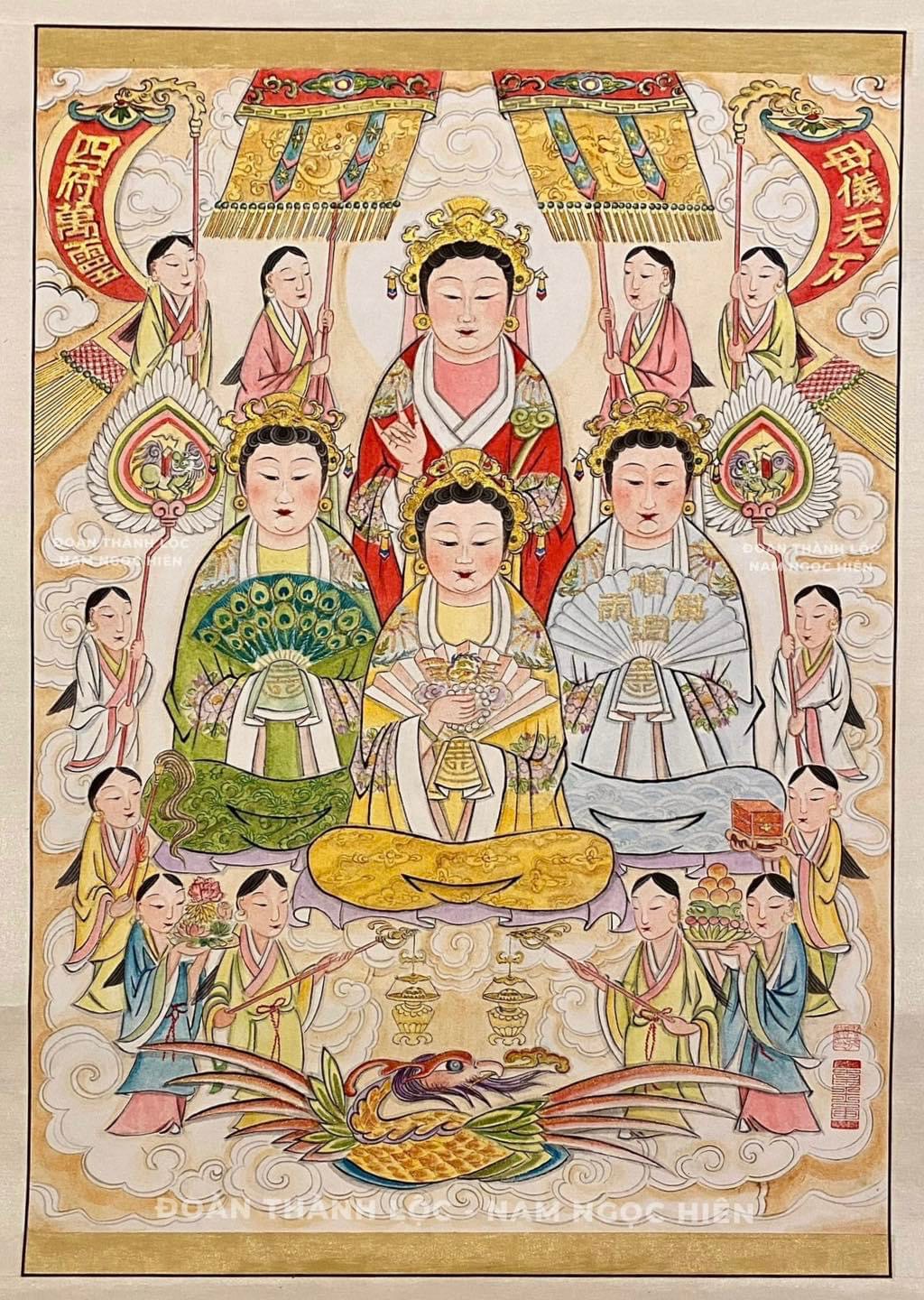
To this point, all requestors have received the prints of this painting. Following their receipt, many have reached out to us, expressing their curiosity about the intricate details that adorn this watercolor art. In response, we are delighted to share our interpretations of the artwork, though we acknowledge that we cannot fully capture all the profound layers of meaning woven into it by the artist, Nam Ngọc Đoàn Thành Lộc.
The painting, titled “Mothers of All People,” is a portrayal of the four Mother Goddesses within the Four Palaces denomination of the Mother Goddess religion (Đạo Mẫu). These divine figures radiate a gentle, benevolent aura as they gaze upon the devoted mortals they protect and nurture. Clad in garments reminiscent of the Lê dynasty, they wear resplendent phoenix headbands, adorned with golden hairpins, and don Giao Lĩnh (cross-collared) dresses, each in a color representative of their respective Palace.
The first among them is the First Mother Goddess of Heaven, known as Princess Cửu Trùng Thanh Vân [九重青雲公主], dressed in a red gown signifying Her connection to the Heaven Palace. Her right hand gracefully forms a mudra that symbolizes the Precious Own Soul, with the index finger pointing upward, signifying Her exalted position of the First Mother Goddess. In Her left hand, She holds a jade Như Ý scepter, a testament to Her capacity to bestow happiness and serenity upon all beings in the universe.
The second in this divine ensemble is the Second Mother Goddess of Earth, Princess Quỳnh Hoa Liễu Hạnh [瓊花柳杏公主]. Draped in a yellow gown to denote Her Earth Palace, She sits prominently at the forefront of the painting, signifying Her central role in the Four Palaces belief. Revered as the goddess who represents the Mother Goddess religion in the mortal realm, She wields a fan adorned with a depiction of a phoenix, the epitome of nobility. In Her other hand, She carries a bead bracelet, as She is a Buddhist and venerated as Bodhisattva Mã Hoàng.
The third figure is the Third Mother Goddess of Water, known as Princess Bạch Ngọc Xích Lân [白玉赤鱗公主]. She is attired in a white gown, symbolizing Her dominion over the Water Palace. Positioned to the left of the painting, She represents the East, with its association with the Eastern Ocean. She holds a white jade fan embellished with the four golden characters, “風調雨順” (Phong Điều Vũ Thuận – Cordial Rains and Harmonious Winds).
The fourth and final deity depicted is the Fourth Mother Goddess of the Mountain, Princess Lê Mại Bạch Anh [黎邁白英公主], in a green gown that signifies Her connection to the Mountain Palace. Positioned to the right of the painting, She embodies the West and its association with the majestic mountain ranges, including Hoàng Liên Sơn and Trường Sơn. In Her delicate grasp, She wields a fan crafted from peacock feathers, a symbol of beauty and nobility, befitting the patron of the mountains.
Surrounding the Mother Goddesses are twelve young goddesses dedicated to their service.
At the apex, a pair of goddesses carry two grand umbrellas. Alongside them, other goddesses wield banners of significance. The banner to the left displays the words 母儀天下 (Mother of the World), while its counterpart on the right bears the words 四府萬靈 (Innumerable Beings of Four Palaces). Beneath these banners, two goddesses elegantly unfurl two grand feather fans, adorned with intricate the patterns of the dragon-horse carrying the precious scripture.
Continuing in this divine ensemble, additional goddesses take on their respective roles. One is entrusted with safeguarding the box containing the seal of Four Palaces, symbolizing their authority over all realms. Others carry the whisker of purification, fragrant blossoms, and delectable fruits. Two goddesses carry a pair of incense burners to lead the procession.
At the base of the painting, a phoenix gracefully draws the celestial carriage of the Mother Goddesses.
The artwork beautifully captures the ethereal procession of the Mother Goddesses upon clouds. As one contemplates this piece, it evokes a sense of the divine, as if these deities have manifested before the altar, in the presence of devoted onlookers. Surrounding them, auspicious clouds symbolize blessings bestowed upon all.
The interpretations offered above provide some of our own insight, gleaned from consultation with our experts. However, this work is a tapestry of meanings, and we eagerly await the day when the artist, Nam Ngọc Đoàn Thành Lộc, may illuminate further aspects of its significance.








